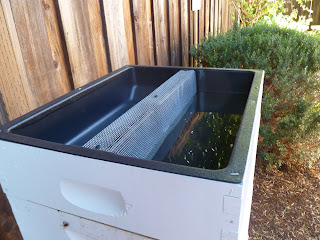I sent the image of the bulging honey and what I thought was a supersedure cell over to Cheryl at Bear Foot Honey (taking advantage of their digital checkins). So when I did another inspection today I tried some of the things that she suggested.
Cheryl said that she thought my supersedure cell was probably a nodule (a false queen cell which is empty). If I took a peek inside the cell, and it was empty, then I could just remove the nodule (because they bees would be wasting their time on the nodule). But, when I took out the frame that had the nodule on it, it was gone! And to boot, my marked queen was on that frame, so it sounds like everything turned out alright with that.
As far as the bulging honey comb goes, Cheryl said that the bees are looking for more space to store honey. I did add the extra deep, but the bees haven't drawn comb on it yet, so they can't really make use of the extra space. The fact that the comb bulges out can be a problem when moving the frames around, so Cheryl suggested that I take my hive tool and squish it down. In doing this, the honey will drip down the frames to the bottom of the hive and the bees will pick it up and move it somewhere else. I probably didn't do this in the smartest fashion - I was inspecting each frame one by one, and as I saw the bulging honey comb, I would smoosh it down. There was some residual honey left on my hive tool, so anything I touched after that had a bit of honey on it. The bees would cluster around the spilled honey and lick it up - but they were usually in the way of me pushing frames around in the hive so it took me longer to do the inspection (since I was trying to nudge bees out of the way much more). Here is a picture of some smooshed bulging honey comb (if you look closely, you can see the bees licking up the spilled honey along the edges of the broken comb):

I also finished the first half of the Apiguard treatments today (the treatment that helps kill the Varroa mites). The bees had put a lot of
propolis around the tray (I saved it because I can hear you can make things out of it - I'll see if there is anything seems worth it). The propolis is the orange stuff around the metal tray, it is very sticky. The bees use it to seal up the hive, humans use if for medicinal purposes and I hear that propolis is even used as varnish for Stradivari violins.
The bees have also made much more progress on the new frame in their bottom deep. They have drawn most of the comb, and have even filled and capped some cells:
In order to encourage the bees to move upstairs to their new box a bit quicker, Cheryl suggested that I move a few brood frames up to the upper deep. I moved two empty frames from the top level down to the bottom as well (the dark frames covered in bees are from the bottom deep - that white thing is shortening with powdered sugar in wax paper. That patty helps guard against
tracheal mites):
Wax production takes approximately 6 times more energy for a bee to produce than honey, so in order to get the bees to produce more wax, I've been supplementing their honey with some sugar water. I put a 1:1 sugar water mix into their feeder (the black thing on the far side of the above picture).

And lastly, I have finally had my first encounter with the pointy end of the bee. I went out to the hive with no protection from the bees just to pick up a few things I had left out there. This wouldn't usually be a problem, but I noticed that I had dripped some honey on the hive stand, so I wiped it up with my finger (bad idea number one). There were a few bees nearby, and two of them started to lick the honey off my fingers - very cute actually. I was very tempted to take a picture of the bees licking honey off of my finger, so I picked up my camera that was nearby and went back to the hive (bad idea number two). As I walked away from the hive a bee flew after me and stung the hand that had the honey on it, I bet she didn't like the idea of me walking away with her honey. All in all, I probably deserved that sting, and it was not nearly the worst thing that I've ever been stabbed by (for those who remember the sea urchin incident where I lost mobility in my left thumb for over a week). This was my first bee sting (ever), and I seem to react the same way as I do to most other insects - the area turns white and swells a bit (there is a lot more soreness than I was expecting though, my pinky still hurts and is swollen and it has been nearly 8 hours. I'm sure I'll live though). The sting is near the base of my pinky.


















































